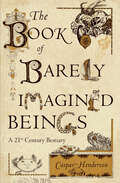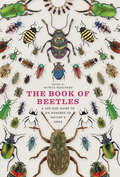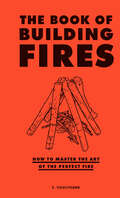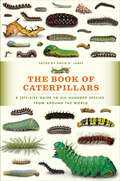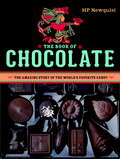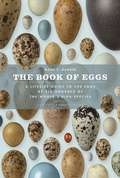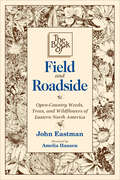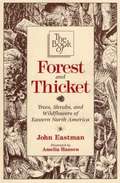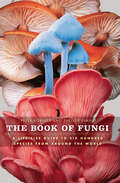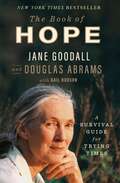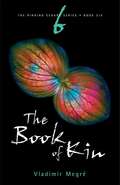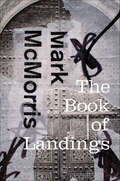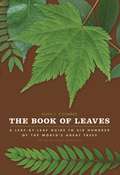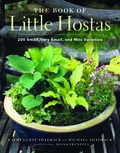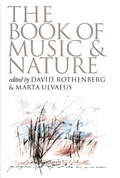- Table View
- List View
The Book of Barely Imagined Beings: A 21st Century Bestiary
by Caspar Henderson“Caspar Henderson takes us on an eye-opening tour of real animals that no sane human could ever have invented.” —Frans de Waal, New York Times–bestselling authorWith The Book of Barely Imagined Beings, Caspar Henderson offers readers a fascinating, beautifully produced modern-day menagerie. But whereas medieval bestiaries were often based on folklore and myth, the creatures that abound in Henderson’s book—from the axolotl to the zebrafish—are, with one exception, very much with us, albeit sometimes in depleted numbers. The Book of Barely Imagined Beings transports readers to a world of real creatures that seem as if they should be made up—that are somehow more astonishing than anything we might have imagined. The yeti crab, for example, uses its furry claws to farm the bacteria on which it feeds. The waterbear, meanwhile, is among nature’s “extreme survivors,” able to withstand a week unprotected in outer space. These and other strange and surprising species invite readers to reflect on what we value—or fail to value—and what we might change.A powerful combination of wit, cutting-edge natural history, and philosophical meditation, The Book of Barely Imagined Beings is an infectious and inspiring celebration of the sheer ingenuity and variety of life in a time of crisis and change.“The Book of Barely Imagined Beings is one that Pliny would have envied, Darwin applauded, and Borges relished . . . In these days of doom and gloom, I can think of nothing more rejoicing than Caspar Henderson’s magical book.” —Alberto Manguel, author of A History of Reading“Magnificent, bravura, beautiful and astoundingly interesting.” —The Sunday Times“Spell-binding, brilliantly executed, extraordinary.” —The Guardian
The Book of Beetles: A Life-Size Guide to Six Hundred of Nature's Gems
by Patrice Bouchard“Profiles 600 of the most stunning, most wonderfully adapted beetles around . . . The result is a work that is nothing short of magnificent.” —WiredWhen renowned British geneticist J. B. S. Haldane was asked what could be inferred about God from a study of his works, Haldane replied, “An inordinate fondness for beetles.” With 350,000 known species, and scientific estimates that millions more have yet to be identified, their abundance is indisputable as is their variety. They range from the delightful summer firefly to the one-hundred-gram Goliath beetle. Beetles offer a dazzling array of shapes, sizes, and colors that entice scientists and collectors across the globe.The Book of Beetles celebrates the beauty and diversity of this marvelous insect. Six hundred significant beetle species are covered, with each entry featuring a distribution map, basic biology, conservation status, and information on cultural and economic significance. Full-color photos show the beetles both at their actual size and enlarged to show details, such as the sextet of spots that distinguish the six-spotted tiger beetle or the jagged ridges of the giant-jawed sawyer beetle. Based in the most up-to-date science and accessibly written, the descriptive text will appeal to researchers and armchair coleopterists alike.The humble beetle continues to grow in popularity, taking center stage in biodiversity studies, sustainable agriculture programs, and even the dining rooms of adventurous and eco-conscious chefs. The Book of Beetles is certain to become the authoritative reference on these remarkably adaptable and beautiful creatures.“Photographs of more than 600 colorful, glossy species, resembling bejeweled broaches morethan creepy crawlies, are presented at actual size.” —Publishers Weekly
The Book of Building Fires: How to Master the Art of the Perfect Fire
by S. CoulthardLearn to construct the best fire, whether it’s in a fireplace, a woodstove, or a campsite in the great outdoors.Straightforward instruction and helpful how-to illustrations provide the wisdom and tools for building a roaring fire with confidence, skill, and efficiency—a fire that people will gather around in admiration. Filled with more than sixty entries on every aspect of fire craft, including sourcing proper wood, chopping and storing, crafting homemade fire starters, building and lighting the perfect stack, and cooking over an open flame, this book also contains a handy chart with information on more than twenty-five species of trees and their wood-burning properties. A must-have for anyone who enjoys the simple satisfaction of gathering around a warm, crackling fire, here is an invitation to celebrate the gifts of slow living and one of life’s most enduring pleasures.
The Book of Caterpillars: A Life-Size Guide to Six Hundred Species from Around the World
by David G. James“For the lover of all things lepidopterous, The Book of Caterpillars is a beautifully curated collection and guide to 600 species from around the globe.” —The American Biology TeacherWhile most of us picture caterpillars as cute fuzzballs munching on leaves, there is much more to them than we imagine. A caterpillar’s survival hinges on finding enough food and defending itself from the array of natural enemies lined up to pounce and consume. And the astounding adaptations and strategies they have developed to maximize their chances of becoming a butterfly or moth are only just beginning to be understood, from the Spicebush Swallowtail caterpillar that resembles a small snake to the Eastern Carpenter Bee Hawkmoth caterpillar that attempts to dissuade potential predators by looking like a diseased leaf.The Book of Caterpillars unveils the mysteries of six hundred species from around the world, introducing readers to the complexity and beauty of these underappreciated insects. With the advent of high-quality digital macrophotography, the world of caterpillars is finally opening up. The book presents a wealth of stunning imagery that showcases the astonishing diversity of caterpillar design, structure, coloration, and patterning. Each entry also features a two-tone engraving of the adult specimen, emphasizing the wing patterns and shades, as well as a population distribution map and table of essential information that includes their habitat, typical host plants, and conservation status. Throughout the book are fascinating facts that will enthrall expert entomologists and curious collectors alike.A visually rich and scientifically accurate guide to six hundred of the world’s most peculiar caterpillars, this volume presents readers with a rare, detailed look at these intriguing forms of insect life.
The Book of Chocolate: The Amazing Story of the World's Favorite Candy
by Hp NewquistChocolate . . . - Its scientific name means “food of the gods.”- The Aztecs mixed it with blood and gave it to sacrificial victims to drink.- The entire town of Hershey, Pennsylvania was built by Milton Hershey to support his chocolate factory. Its streetlights are shaped like chocolate Kisses.- The first men to climb to the top of Mount Everest buried a chocolate bar there as an offering to the gods of the mountain.- Every twenty-four hours, the U.S. chocolate industry goes through eight million pounds of sugar.- Its special flavor is created by a combination of 600 to 1000 different chemical compounds Join science author HP Newquist as he explores chocolate’s fascinating history. Along the way you’ll meet colorful characters like the feathered-serpent god Quetzalcoatl, who gave chocolate trees to the Aztecs; Henri Nestlé, who invented milk chocolate while trying to save the lives of babies who couldn’t nurse; and the quarrelsome Mars family, who split into two warring factions, one selling Milky Way, Snickers, and 3 Musketeers bars, the other Mars Bars and M&M’s. From its origin as the sacred, bitter drink of South American rulers to the familiar candy bars sold by today’s multimillion dollar businesses, people everywhere have fallen in love with chocolate, the world’s favorite flavor.
The Book of Eggs: A Life-Size Guide to the Eggs of Six Hundred of the World's Bird Species
by Mark E. HauberFrom the brilliantly green and glossy eggs of the Elegant Crested Tinamou—said to be among the most beautiful in the world—to the small brown eggs of the house sparrow that makes its nest in a lamppost and the uniformly brown or white chickens’ eggs found by the dozen in any corner grocery, birds’ eggs have inspired countless biologists, ecologists, and ornithologists, as well as artists, from John James Audubon to the contemporary photographer Rosamond Purcell. For scientists, these vibrant vessels are the source of an array of interesting topics, from the factors responsible for egg coloration to the curious practice of “brood parasitism,” in which the eggs of cuckoos mimic those of other bird species in order to be cunningly concealed among the clutches of unsuspecting foster parents.The Book of Eggs introduces readers to eggs from six hundred species—some endangered or extinct—from around the world and housed mostly at Chicago’s Field Museum of Natural History. Organized by habitat and taxonomy, the entries include newly commissioned photographs that reproduce each egg in full color and at actual size, as well as distribution maps and drawings and descriptions of the birds and their nests where the eggs are kept warm. Birds’ eggs are some of the most colorful and variable natural products in the wild, and each entry is also accompanied by a brief description that includes evolutionary explanations for the wide variety of colors and patterns, from camouflage designed to protect against predation, to thermoregulatory adaptations, to adjustments for the circumstances of a particular habitat or season. Throughout the book are fascinating facts to pique the curiosity of binocular-toting birdwatchers and budding amateurs alike. Female mallards, for instance, invest more energy to produce larger eggs when faced with the genetic windfall of an attractive mate. Some seabirds, like the cliff-dwelling guillemot, have adapted to produce long, pointed eggs, whose uneven weight distribution prevents them from rolling off rocky ledges into the sea. A visually stunning and scientifically engaging guide to six hundred of the most intriguing eggs, from the pea-sized progeny of the smallest of hummingbirds to the eggs of the largest living bird, the ostrich, which can weigh up to five pounds, The Book of Eggs offers readers a rare, up-close look at these remarkable forms of animal life.
The Book of Enchanted Living: Reconnect to the magic and wonder of nature
by Sarah BartlettIt's time to let go of disenchanted thinking and embrace enchanted living. . .In a world full of demands and obligations, it is easy to get stuck in the same tiring routines - but what if instead we chose to embrace a life full of joy and enchantment? Nature offers the perfect antidote for weary souls. Carving out time to truly experience and engage with the wonder and beauty of the world around us can help ease our minds, soothe our spirits, and leave us feeling euphoric.This enchanting little book offers rituals, intentions and affirmations that will allow you to commune with nature so that you can belong to both its wildness and its tenderness. By aligning with the rhythms of the natural world, you will learn to reconnect to the enchantment deep within you to live an authentic life filled with meaning and possibility.
The Book of Enchanted Living: Reconnect to the magic and wonder of nature
by Sarah BartlettIt's time to let go of disenchanted thinking and embrace enchanted living. . .In a world full of demands and obligations, it is easy to get stuck in the same tiring routines - but what if instead we chose to embrace a life full of joy and enchantment? Nature offers the perfect antidote for weary souls. Carving out time to truly experience and engage with the wonder and beauty of the world around us can help ease our minds, soothe our spirits, and leave us feeling euphoric.This enchanting little book offers rituals, intentions and affirmations that will allow you to commune with nature so that you can belong to both its wildness and its tenderness. By aligning with the rhythms of the natural world, you will learn to reconnect to the enchantment deep within you to live an authentic life filled with meaning and possibility.
The Book of Field and Roadside: Open-Country Weeds, Trees, and Wildflowers of Eastern North America
by John EastmanThe acclaimed nature writer continues his series exploring the fact and folklore of American plant life with this beautifully illustrated volume. In The Book of Field and Roadside, John Eastman explores the botanical life of open dryland habitats. Picking up where typical field guides leave off, this handy reference takes an ecological approach, providing complete descriptions of eighty-five plants (from Ailanthus to Yucca) found in fields, open meadows, and along roadsides, as well as wildlife communities associated with them. Written in an engaging manner, this book helps readers identify dryland plants, discusses what other organisms, plant and animal, might be found in the same area, and explains why. The informative text is enhanced by beautifully detailed illustrations by nature artist Amelia Hansen.
The Book of Forest and Thicket: Trees, Shrubs, and Wildflowers of Eastern North America
by John EastmanFact and folklore that explore the details of common plant and animal communities east of the rockies.
The Book of Fungi: A Life-Size Guide to Six Hundred Species from around the World
by Shelley Evans Peter Roberts&“The lurid photographs and enticing, offhandedly witty descriptions make the reader want to go out collecting specimens right away."—Popular Science From morels to chanterelles, toadstools to truffles, fungi have been a source of fascination since the earliest hunter-gatherers first foraged for them. Today there are few, if any, places on Earth where fungi have not found themselves a home—their habitats span the poles and the tropics, mountaintops and backyards. Packed with facts and photos, this book introduces you to fungus in many forms—some parasitic, some poisonous, some hallucinogenic and some with healing properties that can be tapped for pharmaceutical products. Then of course, there are the delicious mushrooms that are prized by epicureans and gourmands worldwide. Each species here is reproduced at its actual size, in full color, and accompanied by a scientific explanation of its distribution, habitat, association, abundance, growth form, spore color, and edibility. With information on the characteristics, locations, distinguishing features, and occasionally bizarre habits of these fungi, you&’ll find in this book the common and the conspicuous, the unfamiliar and the odd—including a fungal predator, for instance, that hunts its prey with lassos, and several that set traps, including one that entices sows by releasing the pheromones of a wild boar. &“How dazzling is the world of mushrooms? The fan-shaped cinnabar oysterling looks like something you would find undersea. The violet webcap is vibrant. These are among the more than 600 fungi described and illustrated in this scholarly and beautiful book.&”—TheNew York Times &“Anyone with an appreciation of the beauty of nature will enjoy.&”—Grand Forks Herald
The Book of Hope: A Survival Guide for Trying Times (Global Icons Series)
by Jane Goodall Douglas AbramsIn a world that seems so troubled, how do we hold on to hope? <p><p> Looking at the headlines—the worsening climate crisis, a global pandemic, loss of biodiversity, political upheaval—it can be hard to feel optimistic. And yet hope has never been more desperately needed. <p><p> In this urgent book, Jane Goodall, the world's most famous living naturalist, and Douglas Abrams, the internationally bestselling co-author of The Book of Joy, explore through intimate and thought-provoking dialogue one of the most sought after and least understood elements of human nature: hope. <p><p> In The Book of Hope, Jane focuses on her "Four Reasons for Hope": The Amazing Human Intellect, The Resilience of Nature, The Power of Young People, and The Indomitable Human Spirit. <p><p> Drawing on decades of work that has helped expand our understanding of what it means to be human and what we all need to do to help build a better world.
The Book of Kin (The Ringing Cedars Series #6)
by Vladimir Megré John Woodsworth Leonid SharashkinAnastasia has shown that there exists in Nature some kind of mechanism, some kind of higher power capable of solving a seemingly insoluble problem in an instant. Through a couple's -- a man and a woman's -- specific mental state, this mechanism or power will help them find the conditions and techniques of sexual intercourse appropriate solely to them.
The Book of Landings (Wesleyan Poetry Series)
by Mark McMorrisThe Book of Landings brings together the second and third parts of Mark McMorris's visionary trilogy "Auditions for Utopia,"—initiated in Entrepôt—and marks two stages in the evolution of the poet's conception of space. The first stage of the collection is the entrepôt, a space where disparate vectors of identity congregate, come into conflict, and finally merge into hybrid forms. The poetry follows a trajectory of diaspora, or exile, instigated by conquest, colonialism, wars, and political defeat in the search for Utopia. In The Book of Landings the promised dwelling has been removed from the realm of physical geography, and there is only transition—fragmentary episodes of arrival and departure, in transit from one entrepôt to another. These episodes of transit do not only compose a linear sequence only. Instead, they define a space or surface marked by repeated traversals over time—tracings and, importantly, re-tracings, by explorers, conquerors, migrants, merchants, slaves, refugees, and exiles—a city of palimpsests. An online reader's companion will be available at markmcmorris.site.wesleyan.edu.
The Book of Leaves
by Allen J. Coombes Zsolt DebreczyOf all our childhood memories, few are quite as thrilling, or as tactile, as those of climbing trees. Scampering up the rough trunk, spying on the world from the cool green shelter of the canopy, lying on a limb and looking up through the leaves at the summer sun almost made it seem as if we were made for trees, and trees for us. Even in adulthood, trees retain their power, from the refreshing way their waves of green break the monotony of a cityscape to the way their autumn transformations take our breath away. In this lavishly illustrated volume, the trees that have enriched our lives finally get their full due, through a focus on the humble leaves that serve, in a sense, as their public face. The Book of Leaves offers a visually stunning and scientifically engaging guide to six hundred of the most impressive and beautiful leaves from around the world. Each leaf is reproduced here at its actual size, in full color, and is accompanied by an explanation of the range, distribution, abundance, and habitat of the tree on which it’s found. Brief scientific and historical accounts of each tree and related species include fun-filled facts and anecdotes that broaden its portrait. The Henry’s Maple, for instance, found in China and named for an Irish doctor who collected leaves there, bears little initial resemblance to the statuesque maples of North America, from its diminutive stature to its unusual trifoliolate leaves. Or the Mediterranean Olive, which has been known to live for more than 1,500 years and whose short, narrow leaves only fall after two or three years, pushed out in stages by the emergence of younger leaves. From the familiar friends of our backyards to the giants of deep woods, The Book of Leaves brings the forest to life—and to our living rooms—as never before.
The Book of Leaves: Leaf-by-Leaf Guide to Six Hundred of the World's Great Trees
by Allen J. CoombesOf all our childhood memories, few are quite as thrilling, or as tactile, as those of climbing trees. Scampering up the rough trunk, spying on the world from the cool green shelter of the canopy, lying on a limb and looking up through the leaves at the summer sun almost made it seem as if we were made for trees, and trees for us.Even in adulthood, trees retain their power, from the refreshing way their waves of green break the monotony of a cityscape to the way their autumn transformations take our breath away. In this lavishly illustrated volume, the trees that have enriched our lives finally get their full due, through a focus on the humble leaves that serve, in a sense, as their public face. The Book of Leaves offers a visually stunning and scientifically engaging guide to six hundred of the most impressive and beautiful leaves from around the world. Each leaf is reproduced here at its actual size, in full color, and is accompanied by an explanation of the range, distribution, abundance, and habitat of the tree on which it’s found. Brief scientific and historical accounts of each tree and related species include fun-filled facts and anecdotes that broaden its portrait. The Henry’s Maple, for instance, found in China and named for an Irish doctor who collected leaves there, bears little initial resemblance to the statuesque maples of North America, from its diminutive stature to its unusual trifoliolate leaves. Or the Mediterranean Olive, which has been known to live for more than 1,500 years and whose short, narrow leaves only fall after two or three years, pushed out in stages by the emergence of younger leaves. From the familiar friends of our backyards to the giants of deep woods, The Book of Leaves brings the forest to life—and to our living rooms—as never before.
The Book of Little Hostas: 200 Small, Very Small, and Mini Varieties
by Kathy Guest Shadrack Michael ShadrackHostas are irresistible. Their sculptural leaves and appealing textures make it difficult to stop at one, and it is easy to fill a garden with them. Help is at hand with this attractive guide to the popular new small hostas that take up less space and are ideally suited to container cultivation. They can be used on their own or with companion plants to make charming displays on the patio, porch, or even windowsill. Many small hostas are simply scaled-down versions of classic hostas, while others offer distinctly new attributes in terms of color, leaf shape, and patterning. Like full-size hostas, small hostas can be upright, flat, or cascading; there are varieties that are full of substance, and others that are fine and delicate; there are green ones, gold ones, blue ones, variegated ones, and splashed ones. Some are better garden plants than others, and a valuable function of this book is to showcase the very best of the new introductions. Photographs of the hostas in garden settings show how admirably they respond to imaginative display in a wide range of situations including waterside, woodland, and rock gardens. Beautifully illustrated and highly informative, this handpicked selection of diminutive hostas will inspire hobbyists and gardeners alike and provide inspiration for new planting schemes.
The Book of Music and Nature: An Anthology of Sounds, Words, Thoughts (Music Culture)
by Marta Ulvaeus David RothenbergThis innovative book and soundscapes, assembled by the editors of the renowned periodical Terra Nova, is the first anthology published on the subject of music and nature. Lush and evocative, yoking together the simplicities and complexities of the world of natural sound and the music inspired by it, this collection includes essays, illustrations, and plenty of sounds and music. The Book of Music and Nature celebrates our relationship with natural soundscapes while posing stimulating questions about that very relationship. The book ranges widely, with the interplay of the texts and sounds creating a conversation that readers from all walks of life will find provocative and accessible.The anthology includes classic texts on music and nature by twentieth century masters including John Cage, Hazrat Inrayat Khan, Pierre Schaeffer, Rainer Maria Rilke, and Toru Takemitsu. Innovative essays by Brian Eno, Pauline Oliveros, David Toop, Hildegard Westerkamp and Evan Eisenberg also appear. Interspersed throughout are short fictional excerpts by authors Rafi Zabor, Alejo Carpentier, and Junichiro Tanazaki.The audio includes fifteen tracks of music made out of, or reflective of, natural sounds, ranging from Babenzele Pygmy music to Australian butcherbirds, and from Pauline Oliveros to Brian Eno.
The Book of Music and Nature: An Anthology of Sounds, Words, Thoughts (Music Culture)
by Marta Ulvaeus David RothenbergThis innovative book and online CD, assembled by the editors of the renowned periodical Terra Nova, is the first anthology published on the subject of music and nature. Lush and evocative, yoking together the simplicities and complexities of the world of natural sound and the music inspired by it, this collection includes essays, illustrations, and plenty of sounds and music. The Book of Music and Nature celebrates our relationship with natural soundscapes while posing stimulating questions about that very relationship. The book ranges widely, with the interplay of the texts and sounds creating a conversation that readers from all walks of life will find provocative and accessible.The anthology includes classic texts on music and nature by 20th century masters including John Cage, Hazrat Inrayat Khan, Pierre Schaeffer, Rainer Maria Rilke, and Toru Takemitsu. Innovative essays by Brian Eno, Pauline Oliveros, David Toop, Hildegard Westerkamp and Evan Eisenberg also appear. Interspersed throughout are short fictional excerpts by authors Rafi Zabor, Alejo Carpentier, and Junichiro Tanazaki.The virtual CD at http://www.wesleyan.edu/wespress/musicandnaturecd/ includes fifteen tracks of music made out of, or reflective of, natural sounds, ranging from Babenzele Pygmy music to Australian butcherbirds, and from Pauline Oliveros to Brian Eno.
The Book of Orchids: A Life-Size Guide to Six Hundred Species from Around the World
by Tom Mirenda Mark Chase Maarten Christenhusz“Clear, informative text. It is a superb production, reminding us of the astonishing diversity of these plants.” —Times Literary SupplementOne in every seven flowering plants on earth is an orchid. Yet orchids retain an air of exotic mystery—and they remain remarkably misunderstood and underappreciated. The orchid family contains an astonishing array of colors, forms, and smells that captivate growers from all walks of life across the globe. Though undeniably elegant, the popular moth orchid—a grocery store standard—is a bland stand-in when compared with its thousands of more complex and fascinating brethren, such as the Demon Queller, which grows in dark forests where its lovely blooms are believed to chase evil forces away. Or the Fetid Sun-God, an orchid that lures female flies to lay their eggs on its flowers by emitting a scent of rancid cheese.The Book of Orchids revels in the diversity and oddity of these beguiling plants. Six hundred of the world’s most intriguing orchids are displayed, along with life-size photographs that capture botanical detail, as well as information about distribution, peak flowering period, and each species’ unique attributes, both natural and cultural. With over 28,000 known species, the orchid family is the largest and most geographically widespread of the flowering plant families. Including the most up-to-date science and accessibly written by botanists Mark Chase, Maarten Christenhusz, and Tom Mirenda, each entry in The Book of Orchids will entice researchers and orchid enthusiasts alike.“A luscious coffee-table tome.” —Nature
The Book of Roads: Travel Stories from Michigan to Marrakech
by Phil CousineauCousineau's wanderlust has driven him to visit nearly 100 countries as a backpacker, documentary filmmaker, travel writer, photographer, and art and literary tour leader. For him, travel gives us what his mentor Joseph Campbell called "the key to the realm of the muses." As author of the best-selling travel book The Art of Pilgrimage, Cousineau continues to crisscross the world as a travel writer, filmmaker, and host of Global Spirit. The Book of Roads: Travel Stories from Michigan to Marrakech is the culmination of a lifetime of travel experiences, from the steel factories of Detroit to headhunting villages in the Philippines, the war-torn villages in the Balkans to the river roads of Canada once traversed by his voyageur ancestors. His rhapsodic travel stories place him in the league of fellow travelers who are also masterful writers, such as Pico Iyer, Jack Kerouac, Jan Morris, and Beryl Markham.
The Book of Shells: A Life-Size Guide to Identifying and Classifying Six Hundred Seashell
by M. G. Harasewych Fabio MoretzsohnWho among us hasn't marveled at the diversity and beauty of shells? Or picked one up, held it to our ear, and then gazed in wonder at its shape and hue? Many a lifelong shell collector has cut teeth (and toes) on the beaches of the Jersey Shore, the Outer Banks, or the coasts of Sanibel Island. Some have even dived to the depths of the ocean. But most of us are not familiar with the biological origin of shells, their role in explaining evolutionary history, and the incredible variety of forms in which they come. Shells are the external skeletons of mollusks, an ancient and diverse phylum of invertebrates that are in the earliest fossil record of multicellular life over 500 million years ago. There are over 100,000 kinds of recorded mollusks, and some estimate that there are over amillion more that have yet to be discovered. Some breathe air, others live in fresh water, but most live in the ocean. They range in size from a grain of sand to a beach ball and in weight from a few grams to several hundred pounds. And in this lavishly illustrated volume, they finally get their full due. The Book of Shells offers a visually stunning and scientifically engaging guide to six hundred of the most intriguing mollusk shells, each chosen to convey the range of shapes and sizes that occur across a range of species. Each shell is reproduced here at its actual size, in full color, and is accompanied by an explanation of the shell's range, distribution, abundance, habitat, and operculum--the piece that protects the mollusk when it's in the shell. Brief scientific and historical accounts of each shell and related species include fun-filled facts and anecdotes that broaden its portrait. The Matchless Cone, for instance, or Conus cedonulli, was one of the rarest shells collected during the eighteenth century. So much so, in fact, that a specimen in 1796 was sold for more than six times as much as a painting by Vermeer at the same auction. But since the advent of scuba diving, this shell has become far more accessible to collectors--though not without certain risks. Some species of Conus produce venom that has caused more than thirty known human deaths. The Zebra Nerite, the Heart Cockle, the Indian Babylon, the Junonia, the Atlantic Thorny Oyster--shells from habitats spanning the poles and the tropics, from the highest mountains to the ocean's deepest recesses, are all on display in this definitive work.
The Book of Shells: A Life-Size Guide to Identifying and Classifying Six Hundred Seashells
by Fabio Moretzsohn M.G. HarasewychWho among us hasn’t marveled at the diversity and beauty of shells? Or picked one up, held it to our ear, and then gazed in wonder at its shape and hue? Many a lifelong shell collector has cut teeth (and toes) on the beaches of the Jersey Shore, the Outer Banks, or the coasts of Sanibel Island. Some have even dived to the depths of the ocean. But most of us are not familiar with the biological origin of shells, their role in explaining evolutionary history, and the incredible variety of forms in which they come. Shells are the external skeletons of mollusks, an ancient and diverse phylum of invertebrates that are in the earliest fossil record of multicellular life over 500 million years ago. There are over 100,000 kinds of recorded mollusks, and some estimate that there are over amillion more that have yet to be discovered. Some breathe air, others live in fresh water, but most live in the ocean. They range in size from a grain of sand to a beach ball and in weight from a few grams to several hundred pounds. And in this lavishly illustrated volume, they finally get their full due. The Book of Shells offers a visually stunning and scientifically engaging guide to six hundred of the most intriguing mollusk shells, each chosen to convey the range of shapes and sizes that occur across a range of species. Each shell is reproduced here at its actual size, in full color, and is accompanied by an explanation of the shell’s range, distribution, abundance, habitat, and operculum—the piece that protects the mollusk when it’s in the shell. Brief scientific and historical accounts of each shell and related species include fun-filled facts and anecdotes that broaden its portrait. The Matchless Cone, for instance, or Conus cedonulli, was one of the rarest shells collected during the eighteenth century. So much so, in fact, that a specimen in 1796 was sold for more than six times as much as a painting by Vermeer at the same auction. But since the advent of scuba diving, this shell has become far more accessible to collectors—though not without certain risks. Some species of Conus produce venom that has caused more than thirty known human deaths. The Zebra Nerite, the Heart Cockle, the Indian Babylon, the Junonia, the Atlantic Thorny Oyster—shells from habitats spanning the poles and the tropics, from the highest mountains to the ocean’s deepest recesses, are all on display in this definitive work.
The Book of Snakes: A Life-Size Guide to Six Hundred Species from around the World
by Mark O'SheaFor millennia, humans have regarded snakes with an exceptional combination of fascination and revulsion. Some people recoil in fear at the very suggestion of these creatures, while others happily keep them as pets. Snakes can convey both beauty and menace in a single tongue flick and so these creatures have held a special place in our cultures. Yet, for as many meanings that we attribute to snakes—from fertility and birth to sin and death—the real-life species represent an even wider array of wonders. The Book of Snakes presents 600 species of snakes from around the world, covering nearly one in six of all snake species. It will bring greater understanding of a group of reptiles that have existed for more than 160 million years, and that now inhabit every continent except Antarctica, as well as two of the great oceans. This volume pairs spectacular photos with easy-to-digest text. It is the first book on these creatures that combines a broad, worldwide sample with full-color, life-size accounts. Entries include close-ups of the snake’s head and a section of the snake at actual size. The detailed images allow readers to examine the intricate scale patterns and rainbow of colors as well as special features like a cobra’s hood or a rattlesnake’s rattle. The text is written for laypeople and includes a glossary of frequently used terms. Herpetologists and herpetoculturists alike will delight in this collection, and even those with a more cautious stance on snakes will find themselves drawn in by the wild diversity of the suborder Serpentes.
The Book of Snakes: A Life-Size Guide to Six Hundred Species from around the World
by Mark O'SheaUpdated to reflect the most recent species classifications, a second edition of the beautifully illustrated and beloved guide to 600 members of the suborder Serpentes. For millennia, humans have regarded snakes with an exceptional combination of fascination and revulsion. Some people recoil in fear at the very suggestion of these creatures, while others happily keep them as pets. Snakes can convey both beauty and menace in a single tongue flick, and so these creatures have held a special place in our cultures. Yet, for as many meanings as we attribute to snakes—from fertility and birth to sin and death—the real-life species represent an even wider array of wonders. Now in a new edition, reflecting the most recent species classifications, The Book of Snakes presents 600 species of snakes from around the world, covering roughly one in seven of all snake species. It will bring greater understanding of a group of reptiles that have existed for more than 160 million years and that now inhabit every continent except Antarctica, as well as two of the great oceans. This volume pairs spectacular photos with easy-to-digest text. It is the first book on these creatures that combines a broad, worldwide sample with full-color, life-size accounts. Entries include close-ups of the snake’s head and a section of the snake at actual size. The detailed images allow readers to examine the intricate scale patterns and rainbow of colors as well as special features like a cobra’s hood or a rattlesnake’s rattle. The text is written for laypeople and includes a glossary of frequently used terms. Herpetologists and herpetoculturists alike will delight in this collection, and even those with a more cautious stance on snakes will find themselves drawn in by the wild diversity of the suborder Serpentes.
